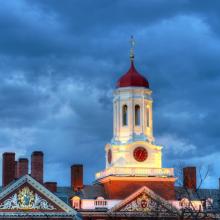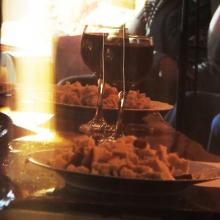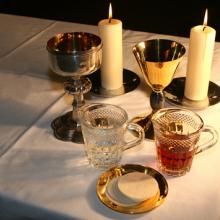eucharist
“I don’t think we talk enough about the delight in sexuality, especially spiritually,” Oladokun told Sojourners. They also take inspiration from the spirit of the Last Supper, comparing queer love to communion and noting “there’s something kind of romantic about Jesus at a candle-lit dinner with a bunch of his bros being like, ‘I am this bread. I am this wine. I am what you can feed off of in this moment.’”
An advisory group to U.S. bishops urged the Catholic leaders on Tuesday to avoid making Communion “a tool for division” as debate resurfaces in Catholic circles over whether President Joe Biden’s support for abortion rights should disqualify him from receiving the sacrament.
Gathered in a Baltimore hotel ballroom, the bishops’ conference is scheduled to discuss a draft of a document clarifying the meaning of Holy Communion, a sacrament central to the faith.
The bishops have been divided over how explicitly the document should define the eligibility of prominent Catholics like Biden to receive Communion due to political stances that contradict church teaching.
Christianity leaves a lot to interpretation — both biblically and apparently, culinarily.
THE UNEXPECTED ELECTION of Donald Trump plummeted me into such a mood of disbelief, emotional reactivity, and political angst that I was losing my spiritual center. Responding on Facebook to the latest outrage, while perhaps politically therapeutic, wasn’t satisfying my soul. I needed to become grounded again with my deepest self and with God.
At a lunch with friends from church to process the aftermath of the election, my wife, Karin, said, “Donald Trump is going to say or do something every day that will arouse us emotionally. And we can’t allow ourselves to be stuck in that place of continuous arousal, responding to him. We have to find safe spaces to support proactively the things we’re called to do.”
More than any in recent memory, this election has sent a spiritual disturbance rippling through society and people’s lives. For many followers of Jesus, and especially those who are not white evangelicals, Donald Trump’s presidency has come to feel like more than a disagreeable political program; rather, it directly contradicts and threatens the integrity of their Christian faith and undermines its public witness. The values underlying the Trump administration, co-mingled with a personality that is narcissistic, pugilistic, and vindictive, has become an assault on what Christian ethics teaches and what we hope our lives stand for.
The inner lives of many have been thrown into spiritual disequilibrium. Even while we search for political responses and may find encouragement in the unprecedented mobilization of the millions marching on every continent, we need to discover the roots for resistance and creative public engagement that can be spiritually sustained for the long run.
I’ll put it this way: When they go low, we go deep.

Image via Tatjana Splichal/Shutterstock.com
In a telephone interview, Bornhoft stood by his critique, but said he understood the sense of powerlessness that seemed to motivate many liturgy shamers:
“There are a lot of liturgical issues today and they don’t trust that leadership can do anything. So they see liturgy shaming as an important and effective tool we didn’t have before.”
Indeed, diehard traditionalists — who tend to be the main liturgy-shamers — say the stakes are too high and they don’t feel they have a choice.

Image via Claudia Daut / REUTERS / RNS
Pope Francis has a knack for setting traditionalist teeth on edge with unscripted musings on sacred topics. He recently did it again when he seemed to suggest that a Lutheran could receive Communion in the Catholic Church after consulting her conscience.
The exchange came up during a prayer service Nov. 15 at a Lutheran church in Rome that had invited the pontiff. And he used the occasion to engage in a question-and-answer session with some of the congregants.
One woman, Anke de Bernardinis, told Francis that she was married to a Catholic and that she and her husband share many “joys and sorrows” in life, but not Communion at church.
“What can we do on this point to finally attain Communion?” she asked.
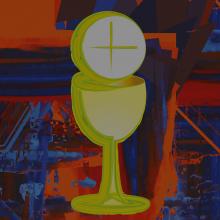
Holy Eucharist, Thoom / Shutterstock.com
I’ve thought about this obedience to vulnerability in light of the current conversation our nation has been having about the refugee crisis, in particular since the attacks in Paris this weekend. The fearful calls to close our border have been disheartening, especially as we begin to enter the season of Advent. Jesus, as God incarnate, saw our sin and flaws and darkness — our hostility even — to the Light and still made himself vulnerable to live among us and die at our hand. Through the cross he offered a generous hospitality to us while we were still enemies of God — a feast of himself, for us to taste and see that God is good.
It should not be any different for us as followers of Christ. As any Christian knows, being part of the Body of Christ is often a dangerous proposition. We are in danger of getting hurt any time we come into contact with another person. We will sin against each other, we will experience conflict, and if we’re doing it right, we’ll bear each other’s suffering. We are knit together with people we may not typically associate, people who view the world in ways we may find misguided at best and dangerous at worst. It doesn’t matter — we’re still invited to the same feast and we’re still joined together in the same family, drinking out of the same cup the way family members and close friends do.

Image via Lisa F. Young / Shutterstock
I still recall that moment when I first heard the words of the liturgy:
“The gifts of God for the people of God. Take them in remembrance that Christ died for you, and feed on him in your hearts by faith, with thanksgiving.”
I had never considered the Lord’s Supper as feeding on Christ. Growing up in a charismatic, non-denominational church and then embracing my faith as an adult at a Presbyterian church, I found this to be a foreign (and admittedly strange) concept that didn’t fully take root in me until after I began attending an Anglican church on Capitol Hill.
As I grappled with unemployment those first months in D.C., feeding on Christ in my heart by faith became more real to me: I didn’t have a seat at the proverbial table, but here was a table prepared for me, full of all the goodness and joy and love and peace and grace I could imagine, because it was Christ who was on offer.
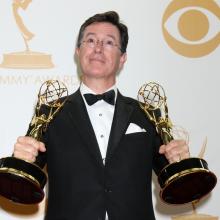
Stephen Colbert at the 65th Emmy Awards on September 22, 2013 in Los Angeles. Photo via Helga Esteb / Shutterstock.com
“I’m no particular exemplar of my faith,” says Stephen Colbert.
“I just happen to have affection for my church.”
Colbert’s latest interview with Toronto-based Catholic outlet Salt and Light is bursting at the seams with wisdom — and, of course, more than a few good laughs.
The new host of the Late Show sat down with Father Thomas Corsica for a 45-minute conversation, one which centered on the Catholic comedian’s reflections on faith and theology.
Raising Themselves
The film Know How, a musical written and acted by foster-care youth, tells interwoven stories of coming of age within a dysfunctional system, the losses and dangers these young people face, and their against-the-odds struggle to persevere. First Run Features
Beyond the Food Drive
In Charity Detox: What Charity Would Look Like If We Cared About Results, Robert D. Lupton asserts that poverty must be addressed “through development, not through one-way giving.” With anecdotes and examples, he explains development strategies such as fund reallocation, reciprocal exchange models, and neighborhood reconciliation. Harper One
I stood at the bread shelf in the neighborhood grocery store, trying to decide which loaf I should buy. Tough decision. I looked at all the types of bread and went back and forth many times.
Which one would be best for communion? I didn’t know. I’d never had to make this choice.
Our pastor was at a conference for the weekend. As the associate minister, I would be presiding over the Sunday service for the first time. Before he left, we went over the details of all that had to be prepared.
He reminded me that I needed to buy the bread for communion.
Uh, I hadn’t thought about that. Where do you get it?
“The grocery store will do just fine.”
So there I was, looking over the loaves, wondering which one looked the most, well, communion-y. Maybe that pretty, round Tuscan loaf. Wait, maybe the nice Jewish rye over there. My wry sense of humor kicked in. Jesus would smile over that, right? Being Jewish and all.
No, better not …
I finally picked an Italian loaf — mainly because it was big and it looked pretty and it was on sale. I put it in my basket and headed for the self-checkout line.
When I scanned the loaf, the automated voice asked: “Do you have any coupons?” No, no communion coupons. Not today.
I swiped my credit card and was reminded that my purchase would earn me a few cents off my next gasoline purchase. How’s that for transubstantiation — bread transformed into bonus points?
When the Word becomes flesh, when the Son of God becomes one who bleeds, Jesus demonstrates God's humble solidarity with human nature from Adam and Eve onward, to the last person born in history.
This vulnerability of God for us, this identification of Jesus with our collective human frailty, changes our perspective on everything. In the light that shines from the face of Jesus Christ, we at last see God and humanity with 20/20 vision.
Paul comes to this vision late in the day, well after the events of God in the flesh that reconcile the Father to God's creation. The vision of Jesus blinds him but when his eyes are healed, having seen Jesus, he sees God and humanity and the world very differently than he did before the vision of Christ that overwhelms him.
Years later, in a letter to the Corinthians, speaking about the church's worship with blest eyes he writes: "When we drink from the cup we ask God to bless, isn't that sharing in the blood of Christ? When we eat the bread we break, isn't that sharing in the body of Christ?"
How do you defeat Satan?
That was the question the University of Harvard had to answer last week when the Harvard Extension School’s Cultural Studies Club planned a satanic “Black Mass” at the university.
The Harvard community, led by Harvard president Drew Faust, was outraged by the Black Mass. Faust addressed the situation by stating, “The ‘black mass’ had its historical origins as a means of denigrating the Catholic Church; it mocks a deeply sacred event in Catholicism, and is highly offensive to many in the church and beyond.” Although Faust was offended by the planned event, she defended the right of the Cultural Studies Club to proceed with the black mass. “Nevertheless, consistent with the University’s commitment to free expression, including expression that may deeply offend us, the decision to proceed is and will remain theirs.”
The Archdiocese of Boston also responded with outraged offense. Cardinal Sean P. O’Malley claimed, “Why people would want to do something that is so offensive to so many people in the community, whether they’re Catholic or not, it’s very repugnant.”
As a Christian, I understand the outrage. After all, the black mass mocks the Eucharist, one of the most holy events in Christianity. But, before we fester in our animosity toward the Satanists, I want to encourage us to take a step back and analyze this event from the angle of mimetic theory.
Interesting fact: The term “breaking bread” goes back many centuries and crosses many cultures and religions. It’s a shared term for coming together in meal and friendship. The term applies today — you can find it in some urban dictionaries.
For as long as we’ve been around, we’ve come together and connected over a meal. We enjoy breaking bread and telling stories, restoring friendships, and creating new ones.
Bread has been a staple of diets for a long time, so it’s a natural choice to capture the essence of eating together. Also, it’s wonderfully symbolic. When we break bread, each of us gets one piece of a bigger loaf. It feeds our sense of connection.
It’s not surprising that bread-breaking is a touchstone religious practice. For instance, it’s part of Jewish tradition. Two thousand years ago, a Jewish rabbi chose it as a way for his followers to remember their unity.
Jesus spent the last years of his life teaching that everyone is responsible for everyone else and must live that way — feed the hungry, give drink to the thirsty, heal the sick, visit the imprisoned, care for the poor. Breaking bread is a reminder that our lives are about more than ourselves.
It was a busy weekend on the eve of Lent for fans of spirited singer and spiritually-minded musician Michael Gungor. If you were not on the Gungor or Michael Gungor Twitter feed over the first two days of March, you might have missed the news about a new band, a new record, and a new mini-tour.
As the band called Gungor takes a short break from touring in support of its sonically and lyrically adventurous album I Am Mountain, the family business has reinvented itself with the proverbial “side project” so common with musical visionaries who cannot contain their creative output to just one brand name or band name.
But The Liturgists — a collective that includes Michael’s wife Lisa, brother David, and a host of other supporting musicians and collaborators — are not just another band, and the brand is “the work of the people.” The band’s Vapor EP is a warm and experimental worship text that includes a song, a spoken-word invocation and incantation, and a guided centering prayer meditation. On the group’s Ash Wednesday-week mini-tour, all the shows are free by RSVP and are not really shows as at all — not as indie-consumers even in the contemporary Christian scene have come to expect.
MOST MEDIA ACCOUNTS of Nadia Bolz-Weber focus on her tattoos. She has the liturgical year tattooed on one arm, from creation to Pentecost; another features Lazarus still wrapped, but very much alive. She got that one while struggling to write a sermon on Jesus’ raised friend.
The tattoos on a 6’1” woman with a taste for punk, a bad-girl past, and a gay-inclusive church—House for All Sinners and Saints in Denver—make for easy picking for secular media. You may have caught Bolz-Weber’s book Pastrix on the New York Times bestseller list. Wise, self-aware, hipster Christian celebrities have a market for books, and she’s tapped it.
In contrast to much of the superficial media coverage, what’s most interesting about Bolz-Weber is her deep traditionalism. “Secular media doesn’t understand the difference between orthodox and conservative,” she tells me through a toothy smile, blue-green eyes blazing over thick-rimmed ’50s-era glasses.
“House,” as the community calls itself, is almost medieval in its liturgy. There are no instruments, just a cappella chant and pillows for kneelers at a prayer station. The Eucharist is served weekly. Eastern Orthodox iconography drapes the church’s interior, stoles, website, and literature. Latin hymns fill the communion liturgy on the Sunday evening I attend. Bolz-Weber is proud to be using Franz Schubert’s setting for the Mass.
This is not high church fussiness; it is liturgical and churchly orthodoxy for scruffy hipsters. Bolz-Weber explains that many of her fellow social progressives want to jettison the Bible and Jesus in order to be more inclusive. “But why should we jettison the only things we have going for us?” she asks.
JOY CARROLL and I were married in 1997. A year later, we had our first son, Luke. We met at a delightful British festival of faith, the arts, and justice called Greenbelt. Joy—a Brit—was on the Greenbelt board and also one of the speakers, as was I. We were on a panel together in a tent with a couple thousand young people, and that’s where our relationship began. I had coffee with Joy afterward, and she told me about the long journey women had made toward ordination in the Church of England.
Joy had been trained as a priest at Durham, just the same as the men, but at that time wasn’t able to be ordained to the priesthood. Her first parish was in a housing estate (what we would call a housing project) in the middle of an impoverished neighborhood with lots of drugs and violence—a place where male priests were afraid to take their families. As a deacon, Joy moved in to live and work in the housing estate, doing everything a priest would do except celebrate the Eucharist, which was still reserved for males only. At age 29, she was elected to the church’s General Synod—its youngest member—and in November 1992 she cast a vote for women’s ordination. Joy went on to become one of the first women ordained as a priest in the Church of England.
When Luke was 4 years old, we found ourselves back at Greenbelt, again as speakers. Sunday morning is always a high point at the Greenbelt festival, with creative and powerful worship that draws most of the 20,000 in attendance. Joy was on the main stage as the chief celebrant of the Eucharist, while Luke cuddled on my lap, carefully watching his mother at the altar. He looked up at me and asked, “Dad, can men do that too?”
SOIL AND SACRAMENT is Fred Bahnson’s story of finding God through sustainable farming. A trained theologian, he learns to best live out his faith with shovel in hand, practicing a method of permanent agricultural design principles called “permaculture.”
We follow him through the liturgical year on an agrarian pilgrimage from one faith community to another, digging into the big question of how to best love his neighbor. His answers are uncovered through building relationships and healthier soil, communing with others and his Creator in the field. From jail cell to monastic cell, from a rooftop in Chiapas to his four-season greenhouse, Bahnson finds the intersection of community and solitude between the field rows. Just like the first Adam from the adamah (earth), we learn how to give more to the soil than we take away and to reverently observe the garden as fruitful and multiplying. “Human from humus”—he had me at hugelkultur. (Look it up—it’s really cool.)
Bahnson begins his pilgrimage in a Trappist monastery in South Carolina during Advent, joining the brothers in prayer and mushroom-growing practices, entering the dark cold winter silence of vigils and the soil. Bahnson then flashes back to 2001, to Holy Week in Chiapas with a Christian Peacemaker Team accompanying the Mayan Christian pacifist civic group Las Abejas—“The Bees.” In Chiapas we sit and eat with Bahnson on Maundy Thursday, corn tortillas and slow-cooked black beans made into holy elements, partaking of an “ancient and unnamed liturgy,” eating our way into mystery. Bahson ordains the creatures of the earth as perennial ministers of the soil, notes the transubstantiation of seed and potluck as Eucharist. He writes of beginning to think of growing food as the embodiment of loving his neighbors, the journey of the liturgical calendar through the mystery of soil. The book is a slow dance, a cosmic one-turn around the sun.
VATICAN CITY — Since mid-July, Pope Francis has been using Communion wafers made by an Argentine prisoner in the daily Mass he celebrates at the Vatican’s Santa Marta residence.
The hosts are made by Gabriela Caballero, a 38-year-old woman who is serving a seven-year jail term in the San Martin Penitentiary outside Buenos Aires.
Her story was revealed by the Argentine news agency NOVA and picked up by Il Sismografo, a blog with close connections to the Vatican.
Caballero gave the hosts, together with a long letter to the pope, to Bishop Oscar Ojea of San Isidro, who regularly visits the prison. Ojea, in turn, delivered the hosts to the pope on July 16 during a visit to the Vatican.
Francis began using the hosts on July 18; the day after he wrote back to Caballero, thanking her for the gift.
So you’ve heard the flu shot is somewhat ineffective this year, and, though you have a normal immune system, you don't want to take the Eucharist from a common chalice.
Part of me kind of wants to slap you.
Obviously, that's not what Jesus would do. We know what Jesus did — he offered you his lifeblood, saying "This is my blood of the covenant, which is poured out for many." Ever after, Christians have taken wine and bread, a sacrament which binds us together in communion with other Christ-followers around the globe and through two millennia.
For the last few months, because my cancer treatment had decimated my immune system, I haven't been able to drink from the common chalice (or to eat most raw food, go to the movies, or get on the bus without a face mask). I really miss it. So I want to share two key insights I’ve had about the common Eucharistic cup.







